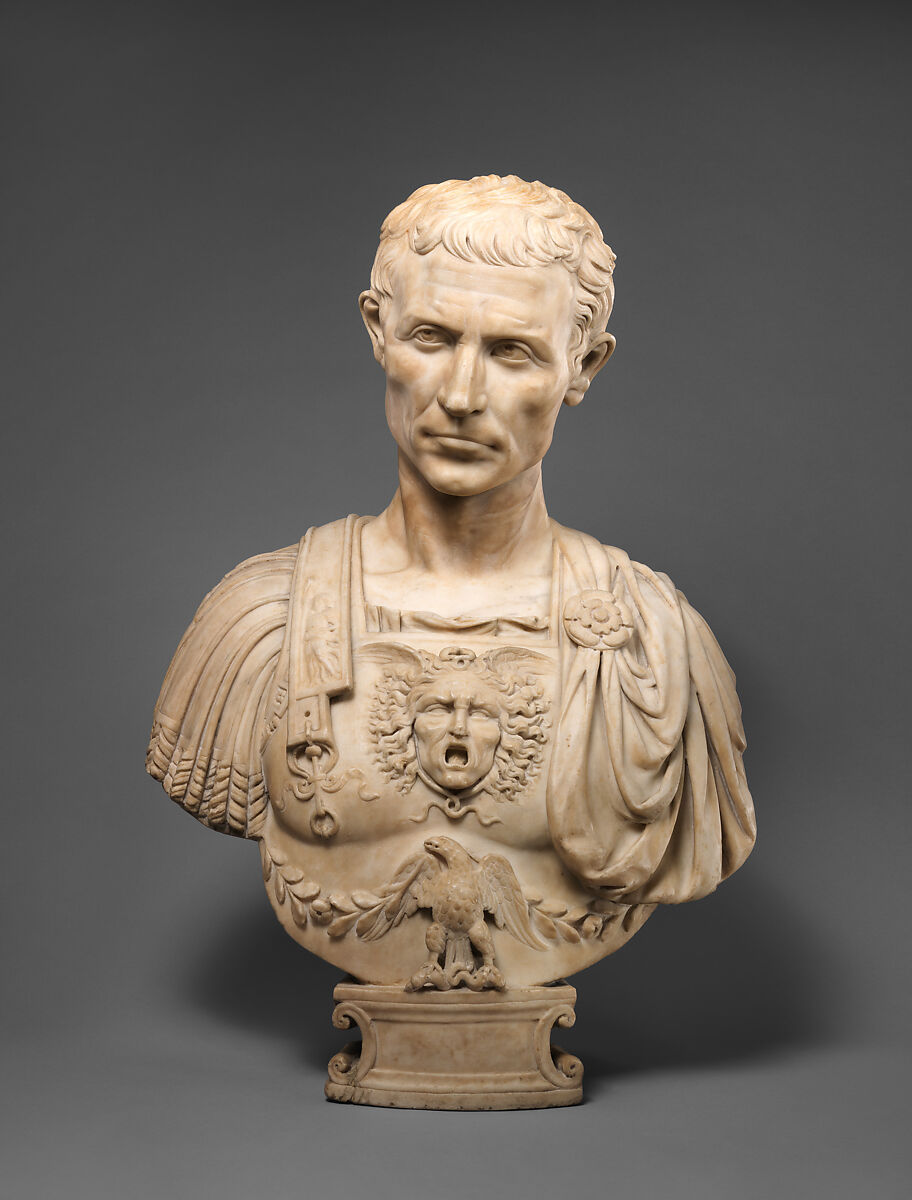100-1 BCE
Roman Rule of Israel
Begins, 63 BCE
The morally corrupt Hasmonean rule continued deep into the 1st Century BCE, where selfish interests ultimately forced them to turn to Rome for mediation, opening the door to total submission under Roman rule. The roots of Rome are tied to the legend of Romulus and Remus in 753 BCE. By 500 BCE, Rome was already an organized republic governed by a senate. The Romans conquered Greece and its colonies and were heavily influenced by Greek culture entrenched in the ancient world. Rome brought with it diligent, disciplined, and methodical values, and revolutionized construction and infrastructure development, leaving behind phenomenal building feats like aqueducts, building structures, highways, and roads. The Romans refined the Grecian battle strategies into systematic and more manoeuvrable battle units called legions. This, in addition to their fiercely competitive, aggressive, and outright brutal approach in battle, made the Roman army an indestructible war machine.
Beit Shean, Israel (Shutterstock)
The First Temple Tax Coin,
87 BCE
Exodus 30:13
Each one… is to give a half shekel, according to the sanctuary weight… half shekel as an offering to the L-rd.
Biblical tithes or "taxes" included the annual half-shekel coin every Jewish male had to bring. In the mid-second century BCE, the Hasmoneans formalized the payment.
The first coin to be specified as acceptable payment for the Temple tax levied was the “Shekel of Tyre.” The coin was probably used for its recognized metal purity grade and weight. It was used from 125 BCE until the outbreak of the Great Revolt in 66 CE.
The Bible mentions different tithes or taxes that the People of
Israel had to give, including tithes to priests, the poor and for the upkeep of the Temple. One of these was the command
that every Jewish male over the age of 20 give ahalf-shekel coin for
communal needs, such as maintaining the Temple and salaries for judges. The
money collection started on the 1st of Adar and finished on the 1st of Nissan,
in preparation for the Jewish people’s ascent to Jerusalem during Passover.
Exodus 30:13
Each one… is to give a half shekel, according to the sanctuary
weight… half shekel as an offering to the L-rd.
In the mid-second century BCE, the Hasmoneans formalized the
payment. The first coin to be specified as acceptable payment for the Temple
tax levied was the “Shekel of Tyre.” The coin was probably used for its
recognized metal purity grade and weight. It was in circulation from 125
BCE until the outbreak of the Great Revolt in 66 CE.
In this picture is a Shekel Coin made of Tyrian
Silver, circa 87/86 BCE
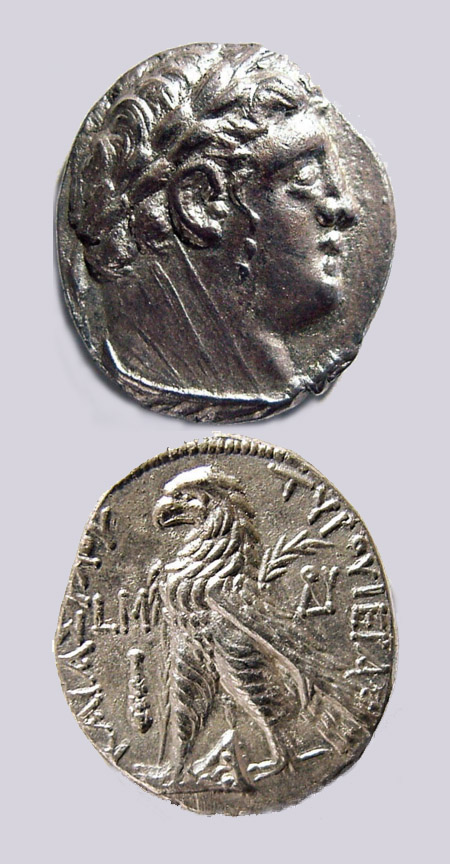
Tyrian Silver Shekel Coin, c. 87/86 BCE
Photo by Sandy Brenner
Biblical Archaeology Society
The Celebration of Purim
In Jerusalem and Alexandria, 78-79 BCE
The Book of Esther in the Septuagint contains a footnote by the scribe that referred to the Book as "The letter of Purim."
Colophon of the Greek Book of Esther:
“In the fourth year of the reign of Ptolemy (XII Auletos) and Cleopatr a (V Tryphaina), Dositheus, who said he was a priest and Levite, and his son Ptolemy brought the present letter of Purim, saying that it was genuine and that Lysimachus, son of Ptolemy, of the community of Jerusalem, had translated it.”
The Jewish-Greek version of the Book of Esther was written in Hasmonean Jerusalem and added several elements to the original story. A colophon appended to the last chapter mentions King Ptolemy XII and Cleopatra V, as well as a man named Dositheus who brought the Greek rendition of the Book of Esther, referred to as the “Letter of Purim”, from Jerusalem to Alexandria in Egypt. It proves that Purim was still celebrated centuries later by Jews in Jerusalem. The Book of Esther is always written in the form of a small scroll; reminiscent of ancient official letters that were rolled up and placed in a protective cylindrical holder to be sent by messengers to their desired destination.
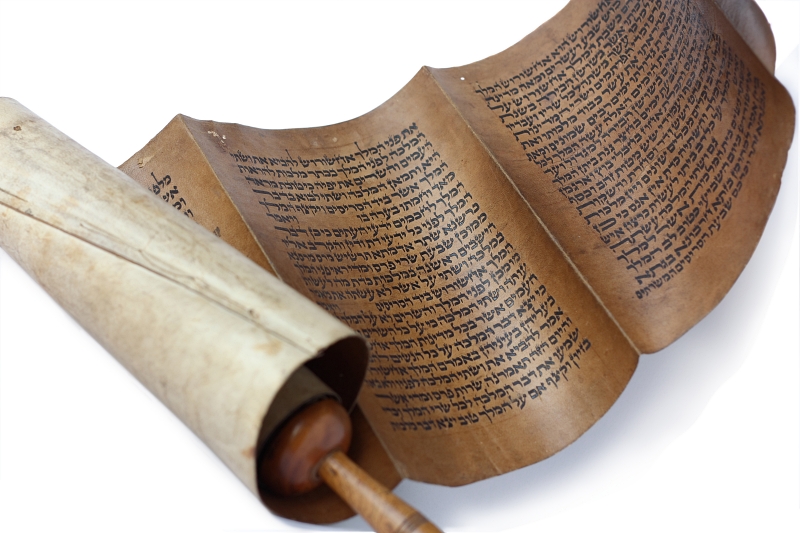
Antique Scroll (Megillat Esther) from which the Book of Esther is read from during Purim (Shutterstock)
Coin of Alexander Jannaeus,
78 BCE
This coin of Alexander Jannaeus features an 8-rayed star and the inscription in Paleo-Hebrew "Yehonatan the King." On the reverse, the coin reads in Greek, "of King Alexander." Christian literature refers to it as the "widow's mite".
In
this picture is the bronze coin or prutah, minted by Alexander Jannaeus, the
Hasmonean King who ruled during the early 1st century BCE.
The coin features an
8-rayed star and the inscription in Paleo-Hebrew "Yehonatan the
King." On the reverse, the coin reads in Greek, "of King
Alexander”.
It is the most common Jewish coin in archaeological records and
was very crudely made, usually minted off-centre on irregular cast metal discs.
Christian literature refers to it as the "widow's mite". Many coins were overstruck with other emblems
reflecting the ongoing civil war.
Overstruck coins will later become an act of
defiance against the Roman rule during the Jewish rebellions.
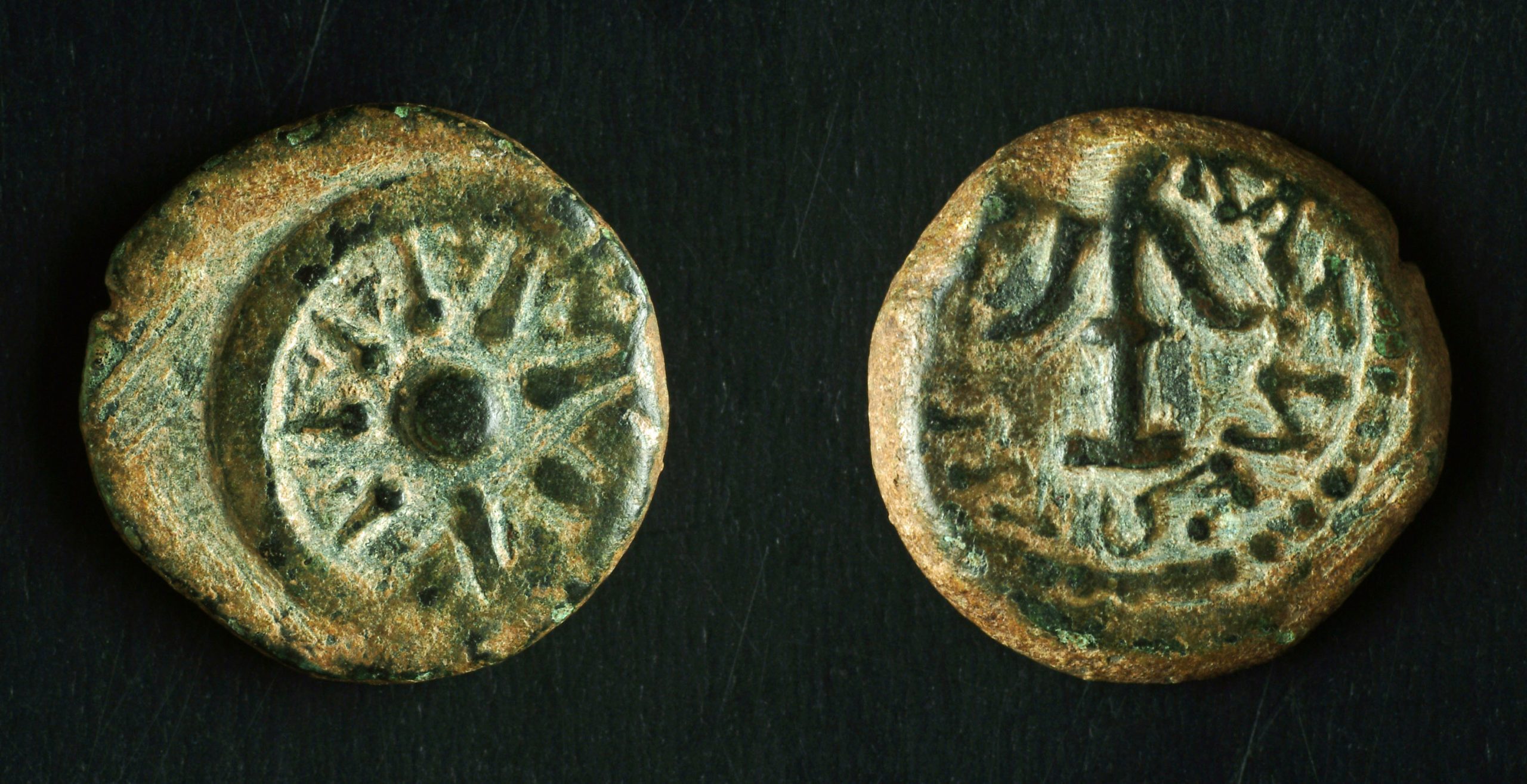
"Yehonatan the King"
"of King Alexander"
Collection of George Blumenthal,
Photo by Ardon Bar-Hama
Wikipedia
Promptuarii Iconum Insigniorum | Guillaume Rouille
Queen Salome Alexandra, 76-67 BCE
Salome Alexandra was the last regnant Queen of Judea.
Josephus, War 1.5.1
"Now Alexander left the kingdom to Alexandra his wife, and depended upon it, that the Jews would now very readily submit to her; because she had been very averse to such cruelty as he had treated them with, and had opposed his violation of their laws, and had thereby got the good-will of the people. Nor was he mistaken as to his expectations; for this woman kept the dominion, by the opinion that the people had of her piety; for she chiefly studied the ancient customs of her country, and cast those men out of the government that offended against their holy laws."
Josephus, Antiquities 13.16.1
"So Alexandra, when she had taken the fortress, acted as her husband had suggested to her; and spake to the Pharisees, and put all things into their power; both as to the dead body, and as to the affairs of the Kingdom: and thereby pacified their anger against Alexander, and made them bear good will and friendship to him… Alexander left behind him two sons: Hyrcanus, and Aristobulus: but committed the Kingdom to Alexandra."
Queen Salome Alexandra, or Shlomtzion in Hebrew, meaning the
"peace of Zion", lived up to her name by bringing a more peaceful
rule to Judea from 141–67 BCE. She was only one of three women to rule over
Israel, the other two being Deborah, the prophetess, and Queen Athaliah. The
wife of Aristobulus I, and afterward of Alexander Jannaeus, Salome was the last
regnant queen of Judea, and the last ruler of Judea to die as the sovereign of
an independent kingdom. She granted liberty to thousands of political exiles
and doubled the size of the army forging extensive foreign connections and was respected
by neighbouring monarchs. Near theend of her reign, Aristobulus, her
son, gathered a large mercenary force and sought to usurp her. She died before
she could counter the uprising, leaving her sons to contend for power.
Josephus, War 1.5.1
"...for this woman kept the dominion, by the
opinion that the people had of her piety; for she chiefly studied the ancient
customs of her country and cast those men out of the government that offended
against their holy laws."
The Sons of Alexander Jannaeus, Hyrcanus II and Aristobolus II, Battle for the Throne, 67-63 BCE
Josephus, Wars 1.6.1
“Now Hyrcanus was heir to the kingdom, and to him did his mother commit it before she died: but Aristobulus was superior to him in power and magnanimity; and when there was a battle between them, to decide the dispute about the kingdom, near Jericho, the greatest part deserted Hyrcanus, and went over to Aristobulus…”
In 63 BCE, in their efforts to claim the Kingdom for themselves, both brothers appealed to Roman General Pompey to intercede on their behalf. This would be one of the key events that would lead to the fall of the Hasmonean dynasty. Pompey and his Roman army besieged and took Jerusalem. Aristobolus II was taken to Rome as a prisoner, and Hyrcanus II, acting in accordance with his advisor Antipater the Idumaean, was restored as High Priest, but not as king. Political authority was retained by the Romans.
After Queen Salome's passing, her two sons Hyrcanus II and Aristobolus II battled for the throne. Josephus, Wars 1.6.1 “Now Hyrcanus was heir to the kingdom, and to him did his mother commit it before she died: but Aristobulus was superior to him in power and magnanimity; and when there was a battle between them, to decide the dispute about the kingdom, near Jericho, the greatest part deserted Hyrcanus, and went over to Aristobulus…” In 63 BCE, in their efforts to claim the Kingdom for themselves, both brothers appealed to Roman General Pompey to mediate their dispute. This would be one of the key events that would lead to the fall of the Hasmonean dynasty. Pompey, happy to oblige, moved in his Roman army, besieged, and took Jerusalem. Aristobolus II was taken to Rome as a prisoner, and Hyrcanus II, acting in accordance with his advisor and strategist, Antipater the Idumaean, was restored by the Romans as High Priest, but not as king. Political authority was retained by Rome effectively ending Jewish independence. Aristobulus II escaped Rome and started another rebellion but was defeatedby a young cavalry commander, Marc Anthony. Pictured here is a silver coin depicting Aristobulus II, kneeling right, holding an olive branch in his right hand, and reins of a camel standing beside him to his left in the battle against Marc Anthony, 55 BCE.

Silver Coin depicting Aristobulus II, kneeling right, holding olive branch in his right hand and reins of a camel standing beside him in his left in the battle against John Hyrcanus, 55 BCE
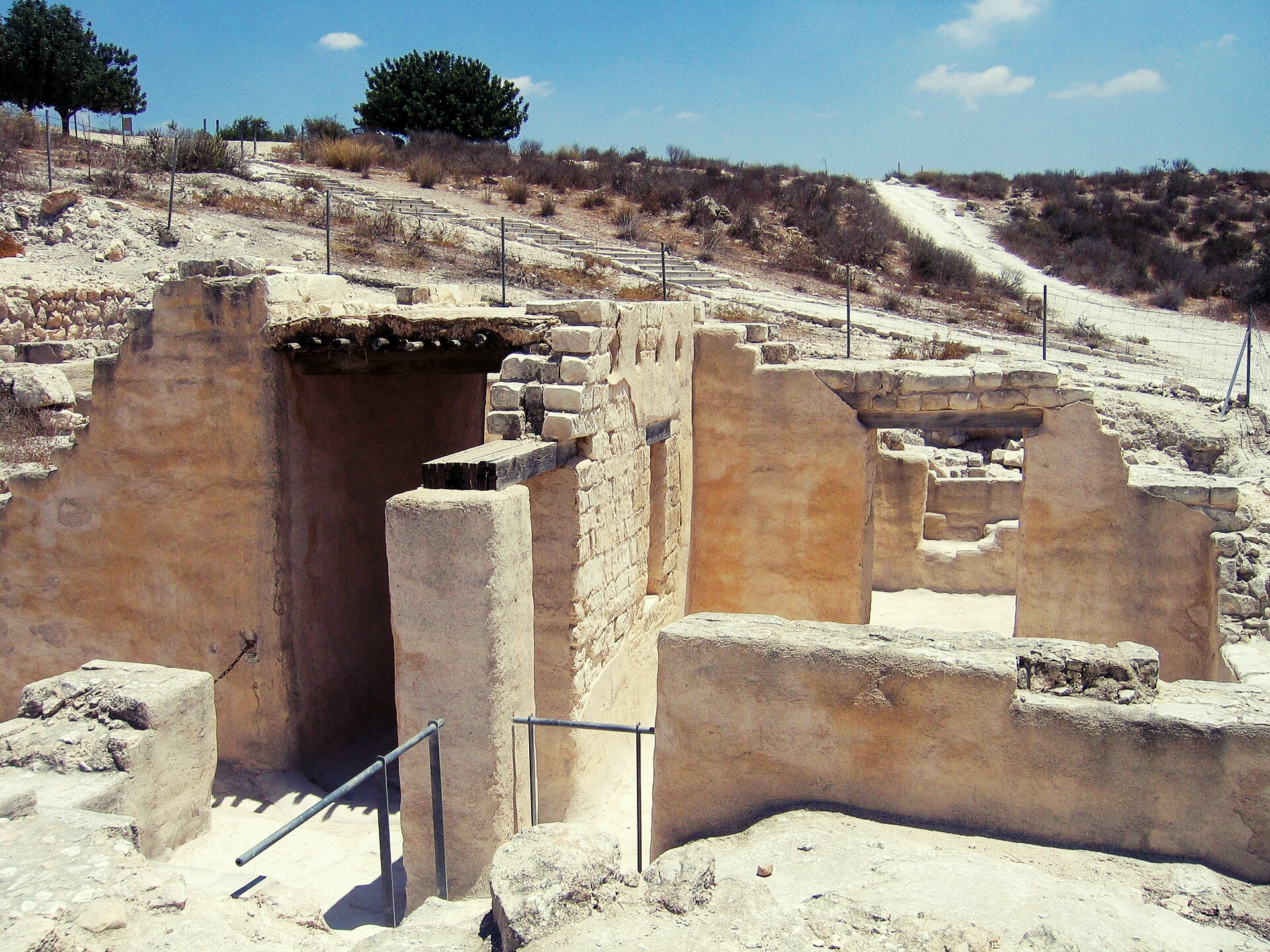
Tel Maresha, Israel. One of the major cities of the Idumeans
Photo: Yair Talmor, Wikipedia
Antipater the Idumaean Becomes Roman Procurator of Judea, 47 BCE
Josephus, Antiquities 14.1.3
“There was a certain friend of Hyrcanus’s, an Idumean, called Antipater; who was very rich, and in his nature an active and a seditious man: who was at enmity with Aristobulus…”
Antipater the Idumean (Father of Herod the Great) was governor of Idumea under King Alexander Jannaeus and Queen Salome of Alexandria. After their deaths, he became an advisor to their son Hyrcanus, spurring him against his brother Aristobulus, out of his own ambition for political power. In 63 BCE, when Pompey instituted Hyrcanus as High Priest, Hyrcanus became a puppet for Antipater. When Antipater led the Jews to rescue Julius Caesar in Egypt in 47 BCE, this show of loyalty persuaded Caesar to appoint Antipater the first Roman Procurator of Judea. Antipater appointed his son Phasael governor of Jerusalem and his son Herod governor of Galilee.
Josephus, Antiquities 14.1.3 “There was a certain friend of Hyrcanus’s, an Idumean, called Antipater; who was very rich, and in his nature an active and a seditious man: who was at enmity with Aristobulus…” Antipater the Idumean, whose father had been forcibly converted to Judaism in the time of John Hyrcanus, was governor of Idumea under King Alexander Jannaeus and Queen Salome of Alexandria. After their deaths, he became the chief advisor to their son Hyrcanus, spurring him against his brother Aristobulus, out of his own ambition for political power. Hyrcanus was a weak figure who could neither administer the affairs of Judea, nor collect its taxes allowing Antipater to insinuate himself into the halls of power. By the time Pompey instituted Hyrcanus as High Priest in 63 BCE, Hyrcanus was but a puppet to Antipater. Antipater led the Jews to rescue Julius Caesar in Egypt in 47 BCE. This show of loyalty persuaded Caesar to appoint Antipater the first Roman Procurator of Judea. Antipater appointed his son Phasael governor of Jerusalem and his son Herod governor of Galilee. Pictured here is the ancient city of Maresha near Beit Shemesh which was one of the major cities of the Idumeans and consists of thousands of man-made caves, mostly cut out of the soft limestone predominant in the area.

Bust of Pompey, copy from original 70-60 BCE,
Venice Archaeological Museum (Wikipedia)
Roman General Pompey the Great Captures Jerusalem,
63 BCE
Josephus, Antiquities, 14.4.4
“But when the battering engine was brought near, the greatest of the towers was shaken by it, and fell down; and brake down a part of the fortifications. So the enemy poured in apace...
Pompey went into it (the Temple).. and saw all that which it was unlawful for any other men to see, but only for the High Priests. There were in that temple the golden table (i.e. the Showbread table); the holy candlestick; and the pouring vessels; and a great quantity of spices: and besides these there were among the treasures, two thousand talents of sacred money.”
When Pompey arrived with his garrisons in Jerusalem, the Jews
resisted. He was able to take the upper city but it took him three months to
reach and take the Temple compound.
Josephus, Antiquities, 14.4.4
For Pompey went into it (the Temple), ... and saw
all that which it was unlawful for any other men to see, but only for the High
Priests. There were in that temple the golden table (i.e. the Showbread table);
the holy candlestick; and the pouring vessels; and a great quantity of spices
(the incense): and besides these, there were among the treasures, two thousand
talents of sacred money. Yet did Pompey touched nothing of all this; on account
of his regard to religion; and in this point also he acted in a manner that was
worthy of his virtue. The next day he gave order to those that had the charge
of the temple to cleanse it, and to bring what offerings the law required to
G-d and restored the High Priesthood to Hyrcanus.
Roman Praetor Lucius Valerius Flaccus Seizes the Temple Tribute, 62 BCE
Cicero’s Defense of Flaccus in 59 BCE:
“When every year it was customary to send gold to Jerusalem on the order of the Jews from Italy and from all our provinces, Flaccus forbade by an edict its exportation to Asia (Jerusalem).
… At Apamea a little less than a hundred pounds of gold was openly seized at Laodicea a little more than twenty pounds. At Adramyttium hundred pounds, at Pergamum a small amount.”
In 62 BCE, Lucius Valerius Flaccus prevented the Jews of his province from sending the tribute due to the temple of Jerusalem, and diverted that money instead into his own treasury. Due to a masterly defense by Marcus Tullius Cicero, he was acquitted and escaped a merited punishment. Cicero was a leading political figure of the era of Julius Caesar, Pompey, Marc Antony, and Augustus and one of the greatest orators of Rome. His works are well-known and read even today. His defense speech in the Flaccus case was riddled with strong antisemitic undertones. Although Flaccus' confiscation of the Jewish gold was vindicated in this trial, there was no evidence that the ban on the export of this gold was applied further, and we may assume that the Jews of Rome, Italy, and the provinces continued to make their annual contributions to the Temple. Click on the Read More button to view Cicero's full speech.
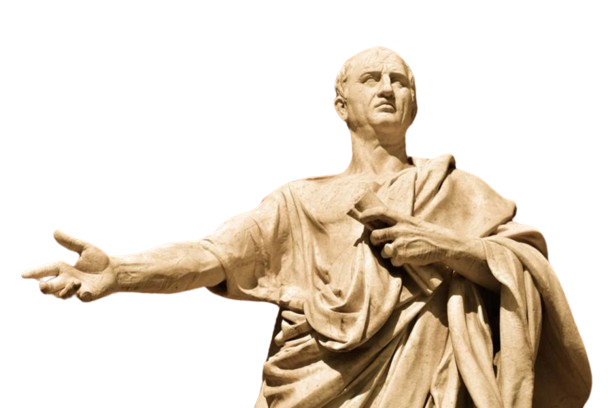
Statue of Marcus Tulius Cicero, Rome, Italy

Bust of Cleopatra VII,
Altes Museum, Berlin
Jewish Soldiers Rescue Roman Emperor Julius Caesar and Queen Cleopatra VII in Alexandria, Egypt, 47 BCE
After Cleopatra VII seduced Julius Caesar in 48 BCE, he found himself trapped in Cleopatra’s palace in Alexandria, Egypt surrounded by Ptolemy’s army.
Josephus, Antiquities, 14.8.1
“Antipater (Father of Herod “the Great”), who managed the Jewish affairs (for the Romans in the Land of Israel), became very useful to Caesar, when he made war against Egypt; …Antipater came to him (Caesar), conducting three thousand of the Jews armed men.” “…Antipater persuaded [the Jews of Egypt] to come over to their party…”
The romantic relationship between Julius Caesar and Cleopatra VII
is well known. During the civil war between Caesar and Ptolemy the Great,
Julius Caesar found himself trapped in Cleopatra’s palace in Alexandria, Egypt
surrounded by Ptolemy’s army.
In March 47 BCE, news reached him of a relief force arriving
overland from Syria. This consistedof
an allied army with a detachment of three thousand Jews contributed by High
Priest Hyrcanus II and led by Antipater the Idumaean.
Josephus, Antiquities, 14.8.1
“Antipater
(Father of Herod “the Great”), who managed the Jewish affairs (for the Romans
in the Land of Israel), became very useful to Caesar when he made war against
Egypt; …Antipater came to him (Caesar),
conducting three thousand of the Jews armed men.” “…Antipater persuaded [the Jews of Egypt] to
come over to their party…”
Roman Emperor Julius Caesar Rewards the Jews For Rescuing Him and Cleopatra, 47 BCE
Josephus, Antiquities, 14.10.1,5
“Julius Cesar made a pillar of brass for the Jews at Alexandria; and declared publicly that they were citizens of Alexandria.
…
Julius Caesar, consul the fifth time, hath decreed, that the Jews shall possess Jerusalem.”
Pompey dealt harshly
with the Jews during his reign. He was remembered as the general who had slain
many Jews in his assault on Jerusalem, violating the sanctity of the Holy of
Holies and enslaving many Jews afterward. The Jews did not only rally to assist
Julius Caesar during the war in Alexandria but gave their support to him
wholeheartedly. Julius, in return, showed them abundant favor and his decrees
on their behalf, which, fortunately, wererecorded
by Josephus, have been called the Magna Carta of the Jews. Because of their
refusal to bear arms or march due to the sanctity of the Sabbath and their
kosher dietary laws, Caesar exempted them from compulsory military service.
Special Jewish courts were recognized for Jews to be tried by a Jewish tribunal
instead of the regular Roman courts. They enjoyed these special privileges in
Rome and across the Empire for more than three centuries, until the rule of the
Christian emperors.
Josephus, Antiquities,
14.10.1,5
“Julius Caesar
made a pillar of brass for the Jews at Alexandria; and declared publicly that
they were citizens of Alexandria. … Julius Caesar, consul the fifth time, hath
decreed, that the Jews shall possess Jerusalem.”


In this picture is a rare golden coin commemorating the Ides of March assassination. On the 15th of March, 44 BCE, infamously known as the Ides of March, Julius Caesar was assassinated by a group of senators in a conspiracy led by Marcus Junius Brutus and two other senators. Marcus Antonius, better known as Mark Antony, a Roman politician, general and relative of Julius Caesar sided with two other generals, Gaius Octavius and Marcus Lepidus, and defeated Caesar's killers in 42 BCE. Known as the Second Triumvirate, they divided the government between themselves. Antony was assigned Rome's eastern provinces, including the province of Judea and the client kingdom of Egypt, then ruled by Cleopatra VII. Gaius Octavius would later change his name to Augustus. Josephus, Antiquities 14.10.9 Now after Caius (i.e. Julius Caesar) was slain, when Marcus Antonius, and Publius Dolabella, were consuls, they both assembled the senate and introduced Hyrcanus’s (High Priest of the Jews) ambassadors into it. They discussed their desires, and formed a league of friendship with them. The senate then decreed to grant them all they requested.
The Ides of March
Denarius of Brutus Coin Commemorating the Assassination of Julius Caesar, March 15th, 44 BCE
Josephus, Antiquities 14.10.9
Now after Caius (i.e. Julius Caesar) was slain, when Marcus Antonius, and Publius Dolabella, were consuls, they both assembled the senate, and introduced Hyrcanus’s (High Priest of the Jews) ambassadors into it, and discoursed of what they desired, and made a league of friendship with them. The senate also decreed to grant them all they desired.

Haim Gitler, Israel Numismatics Research
Cleopatra VII Coin, 41 BCE
Minted in Ashkelon, Israel
Josephus, Antiquities, 14.13.1
"When after this Antony came into Syria, Cleopatra met him in Cilicia, and brought him to fall in love with her."
Cleopatra VII Thea Philopator was the ruler of Egypt from 51 – 30
BCE. As Pharaoh, she consummated a liaison with Gaius Julius Caesar that
solidified her grip on the throne. After Caesar’s assassination, Cleopatra
aligned with Mark Antony. Cleopatra had four children, one by Caesar and three
by Antony. Her reign marks the end of the Hellenistic Era and the beginning of
the Roman Era in the eastern Mediterranean. She was the last Pharaoh of Ancient
Egypt.
Josephus, Antiquities, 14.13.1
"When after this Antony came into Syria, Cleopatra met him in
Cilicia, and brought him to fall in love with her."
Pictured here is a silver coin with the bust of
Cleopatra VII minted in Ashkelon, Israel. Ashkelon was a well-established mint
since 104 BCE.
Mattathias Antigonus, The Last Hasmonean King of Judea,
40-37 BCE
Mattathias Antigonus (Antigonus II Mattathias) was the son of Aristobulus II. When Aristobulus II was carried to Rome as a prisoner of Pompey in 63 BCE, Mattathias Antigonus was carried with him. However, in 57 BCE, Mattathias Antigonus escaped and returned to Judea. In 47 BCE, Antigonus appealed to Julius Caesar in Syria, claiming that his uncle Hyrcanus II was a puppet of Antipater the Idumaean (father of Herod the Great) and in 42 BCE, he attempted to take control of the government of Judea. Embassies of Jews appealed to Mark Antony bringing accusations against Antipater’s sons Herod and Phasael. Mark Antony sided with the Herodians, and had members of the Jewish delegation put to death.
In 40 BCE, Mattathias formed an alliance with the fiercely anti-Roman Parthians and regained the throne of his fathers, as Herod fled Jerusalem for the fortress of Masada.
Pictured here is a copper alloy pruta coin with traces of the paleo-Hebrew inscription (מתתיה כהן גדל) Mattathias the High Priest, encircling the showbread table. On the reverse is a Greek inscription "of the king Antigonos" around the Temple Menorah. Mattathias Antigonus was the son of Aristobulus II who was taken to Rome as a prisoner of Pompey in 63 BCE. Mattathias Antigonus was taken with his father but managed to escape in 57 BCE and returned to Judea. In 47 BCE, Antigonus appealed to Julius Caesar in Syria, claiming that his uncle Hyrcanus II was a puppet of Antipater the Idumaean but the petition fell on deaf ears. In 43 BCE, Antipater was poisoned, but his sons Herod and Phasael managed to retain power in Judea. In 42 BCE, Antigonus attempted to take control of the government of Judea sending delegations of Jews to appeal to Mark Antony against Antipater’s sons Herod and Phasael, but again Antony sided with the Herodians. Their fate changed decidedly with the Parthian invasion in 40 BCE when Mattathias, the last of the Hasmonean princes who had long been seeking to reassert Hasmonean rule over Judea, formed an alliance with the fiercely anti-Roman Parthians, and regained the throne of his fathers. During the invasion, Phasael took his own life as Herod fled Jerusalem for the fortress of Masada.
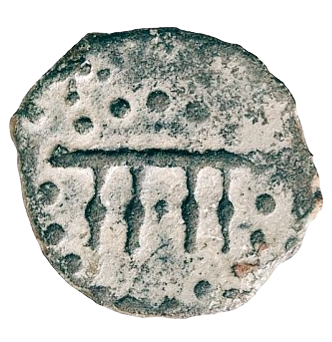
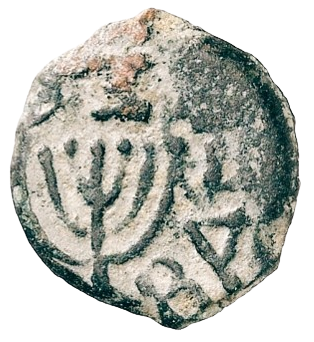
Copper alloy pruta coin with traces of the palaeo-Hebrew inscription (מתתיה כהן גדל) Mattathias the High Priest encircling the showbread table. Reverse Greek inscription "of the king Anitgonos" around the Tmeple Menorah.
Herod Appeals to the Romans
Herod was determined to regain power in Judea. His father Antipater and his brother Phasael were now both dead, so Herod set sail to Rome in order to appeal to the Roman Senate for their support.
Josephus, Wars, 1.14.4
"Hereupon Antony was moved to compassion at the change that had been made in Herod’s affairs, and this both upon his calling to mind how hospitably he had been treated by Antipater, but more especially on account of Herod’s own virtue: so he then resolved to get him made king of the Jews..."
Herod returned to Judea with a large Roman army, captured Jerusalem and sent Mattathias Antigonus as a prisoner to Rome.
Determined to regain power, Herod set sail for Rome, where he
persuaded the Senate to declare him king of Judea.
Josephus, Wars, 1.14.4
"Hereupon Antony was moved to compassion at the change that
had been made in Herod’s affairs, and this both upon his calling to mind how
hospitably he had been treated by Antipater, but more especially on account of
Herod’s own virtue: so he then resolved to get him made king of the
Jews..."
In 39 BCE, Herod returned to Judea with a large
Roman army. His first attack on Jerusalem was unsuccessful, with Antigonus
still holding his own in the city. By 37 BCE, Herod had subdued virtually all
of the country and ultimately captured Jerusalem. Mattathias Antigonus was
taken as a prisoner to Rome.
Wikipedia: Web Gallery of Art:Canaletto
Mattathias Antigonus Is
Murdered by Roman General Mark Antony, 37 BCE
Josephus, Antiquities, 14.16.4
“Herod…, by giving (Mark) Antony a great deal of money, endeavored to persuade him to have (Mattathias) Antigonus slain…And thus did the government of the Hasmoneans (Israelites) cease, a hundred twenty and six years after it was first set up.”
Later in the year 37 BCE, Herod, fearing that Antigonus might regain
power due to his noble birth and claim to the throne, offered Mark Antony a
large sum of money to have Mattathias Antigonus killed.
Josephus, Antiquities, 14.16.4
“Herod…, by giving Antony a great deal of money,
endeavored to persuade him to have Antigonus slain…And thus did the government
of the Hasmoneans cease, a hundred twenty and six years after it was first set
up.”

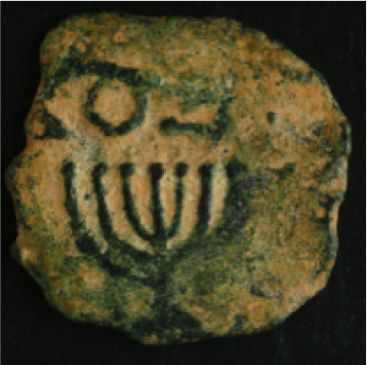
The earliest representations of both the Menorah and the Showbread Table from the Temple, depicted on the Coin of Mattathias Antigonus
Collection of George Blumenthal
Mark Antony Establishes
Herod “the Great” as Roman Client King of the Land of Israel 37 BCE
Josephus, Antiquities 15.1.1
"And since Herod had now the government of all Judea put into his hands, he promoted such of the private men in the city, as had been of his party; but never left off avenging and punishing, every day, those that had chosen to be of the party of his enemies."
Herod, now appointed as the client King of Judea by Antony and the
senate, asserted his power by promoting those in his party and brutally
punishing those who opposed him.
Josephus, Antiquities 15.1.1
"And since Herod had now the government of all Judea put
into his hands, he promoted such of the private men in the city, as had been of
his party; but never left off avenging and punishing, every day, those that had
chosen to be of the party of his enemies."
Click the button to view the Israel Museum’s
virtual tour of Herod the Great.
Herod the Great Exhibit at the Israel Museum, Jerusalem
Mark Antony and Cleopatra VII, 36 BCE
Josephus, Wars, 1.18.5
“He (Antony) also took away a great deal of their (the Jews) country; nay, even the plantation of palm trees at Jericho (Qumran and Ein Gedi), where also grows the balsam tree, and bestowed them upon her (Cleopatra VII)…”
Covetous in nature, Cleopatra convinced an infatuated Antony to seize territory for her in Arabia and Judea, including the City of Jericho, where it was believed to be the only place where true balsam grew, the most precious drug of the ancient world. This territory previously belonged to Herod. She leased the land back to him for an annual rent of 200 talents. Josephus, Wars, 1.18.5 “He (Antony) also took away a great deal of their (the Jews) country; nay, even the plantation of palm trees at Jericho (Qumran and Ein Gedi), where also grows the balsam tree, and bestowed them upon her (Cleopatra VII)…”

Cleopatra (left), wearing jeweled headband, earring, necklace, and embroidered dress,
Mark Antony on the right with the inscription: “Antony, with Armenia being conquered."
The Israel Museum, Jerusalem

Queen Cleopatra VII and Herod the Great, 35 BCE
Flavius Josephus, Antiquities, 15.4.2
When Cleopatra had obtained thus much (from Mark Antony)… she returned back, …and passed on to Judea, where Herod met her, and farmed (for) her… the region about Jericho.
This country bears that balsam, which is the most precious drug that is there, and grows there alone…
When she was there, and was very often with Herod, she endeavored to have criminal conversation with the king;… she laid a treacherous snare for him, by aiming to obtain such adulterous conversation from him: however, upon the whole, she seemed overcome with love to him.
In 35 BCE, Cleopatra visited Herod for the collection of balsam to be taken back to Egypt. According to Josephus, she made open advances at Herod. She might've well had feelings for him, but it was mostly suspected that she was laying a snare for him. Herod himself bore hatred towards Cleopatra and entertained thoughts of killing her. He took counsel with his friends who urged him not to, as he would be facing Mark Antony's wrath in the process. He dealt with her respectably but at arm's length and accompanied her on her way back to Egypt. Josephus, Antiquities, 15.4.2When Cleopatra had obtained thus much (from Mark Antony)… she returned back, …and passed on to Judea, where Herod met her, and farmed (for) her… the region about Jericho. This country bears that balsam, which is the most precious drug that is there, and grows there alone… When she was there, and was very often with Herod, she endeavoured to have criminal conversation with the king;… she laid a treacherous snare for him: however, upon the whole, she seemed overcome with love to him.
"The Balm of Gilead" Depicted on a 2,000 Year-Old Amethyst
The balsam tree, known as the "balm of Gilead" in the Bible, was used in the production of perfumes, and said to be a favorite of Cleopatra's. In 2021, archaeologists discovered this depiction of a balsam tree carved into an amethyst gemstone from the Second Temple period in Jerusalem.
Learn MoreThe balsam tree, known as the "balm of Gilead" in the Bible, was used in the production of perfumes and said to be a favourite of Cleopatra's. In 2021, archaeologists discovered this depiction of a balsam tree carved into an amethyst gemstone from the Second Temple period in Jerusalem. Watch the video to learn more about the gemstone as well as the production of ancient balsam in Israel in the Jericho area.
The City of David, Photo by Eliyahu Yanai
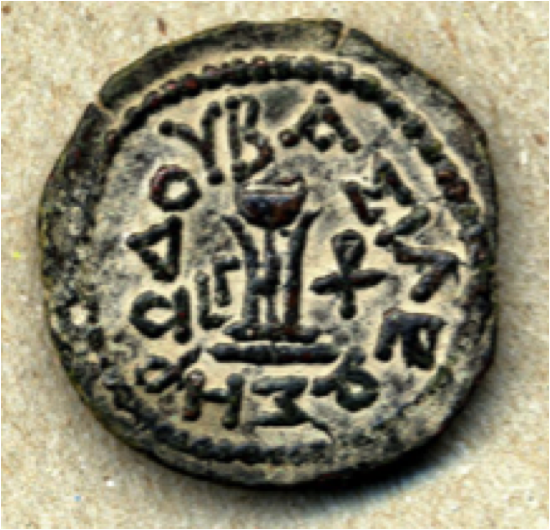
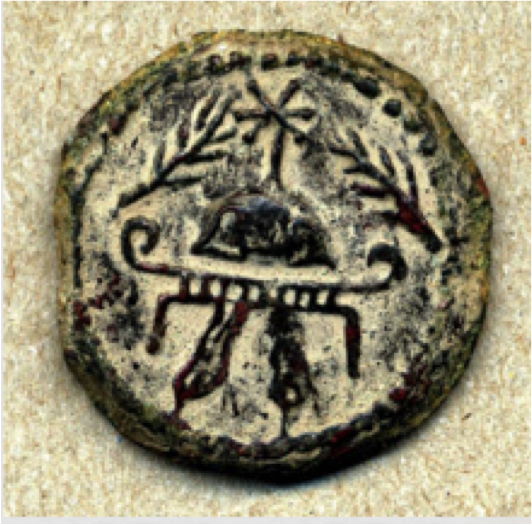
Herod the Great left a legacy of being one of the greatest builders in human history but was also known as paranoid, psychologically unstable, and a brutal tyrant. Instituting major changes in Jewish coinage, Herod still followed biblical restrictions with none of his coins being minted with human representations. The coins however diverged from their predecessors with their inscriptions only in Greek and not Hebrew or Aramaic. He included mainly pagan or Roman symbols with minimal traditional Jewish symbols. He also initiated a system of dating for coins. Pictured here is a bronze coin minted by Herod, part of the George Blumenthal collection. On the obverse is written BASILEOS ERODOU “Herod the King” with a tripod holding a bowl and the date "year 3" corresponding to 35 BCE. On the reverse is an incense burner between two palm branches. The earlier coins are believed to still display vessels used in the Temple.
Collection of George Blumenthal
Bust of Augustus, Wikipedia, Gautier Poupeau
Caesar Augustus
r. 27 BCE - 14 CE
Josephus, Wars, 1.14.4
“And, when the senate was separated, Antony and Cæsar (Augustus) went out, with Herod between them; while the consul and the rest of the magistrates went before them, in order to offer sacrifices… Antony also made a feast for Herod on the first day of his reign.”
______
Augustus was the first Roman Emperor. The policies of Augustus toward the Jews of the Roman Empire in general, and the inhabitants of Judea in particular, followed the favorable line established by Julius Caesar.
Herod’s rule in Judea was contemporaneous with the rule of Augustus. He approved of Herod's efforts to introduce Roman culture into Judea and for this reason paid little heed to the claims of Herod's enemies, foreign and domestic.
Together with Mark Antony and Marcus Lepidus, Gaius Octavius was part of the three generals who defeated Caesar's assassins. Josephus, Wars, 1.14.4 “And, when the senate was separated, Antony and Cæsar (Octavian) went out, with Herod between them; while the consul and the rest of the magistrates went before them, in order to offer sacrifices… Antony also made a feast for Herod on the first day of his reign.” Competing ambitions soon tore the Second Triumvirate apart. Lepidus was exiled in 36 BCE and in 31 BCE at the Battle of Actium, Octavian won a decisive victory over his rival Mark Antony and his Egyptian fleet. Returning to Rome, he strategically secured his position as the first Emperor of Rome. He defeated Antony and Cleopatra's forces in Alexandria in 30 BCE after which Antony and Cleopatra committed suicide. In 27 BCE, the Senate gave Octavian the new title of Augustus hinting to his divine status. As an adopted son of Julius Caeser who was deified posthumously, he referred to himself as the "Son of the Divine". The policies of Augustus toward the Jews of the Roman Empire in general, and the inhabitants of Judea in particular, followed the favourable line established by Julius Caesar. Herod’s rule in Judea was contemporaneous with the rule of Augustus. He approved of Herod's efforts to introduce Roman culture into Judea and for this reason paid little heed to the claims of Herod's enemies, foreign and domestic.
Masada and its Synagogue,
c. 31 BCE
Herod the Great rebuilt the fortress at Masada as a palace retreat. In the 1960s, archaeologists uncovered a Synagogue there used by Jews during the time of the Great Revolt (66-74 CE). Two shallow pits found in the floor of the Synagogue at Masada contained scrolls: a copy of Deuteronomy and a copy of Ezekiel .
Josephus, Wars 7.8.3
Upon this top of the hill Jonathan the High-priest first of all built a fortress; and called it Masada. After which the rebuilding of this place employed the care of King Herod to a great degree.
Learning more about Herod's tremendous building feats, the Fort of Masada is especially impressive; due to its magnificent structure situated on top of a high, isolated rock plateau in an arid desert. In Hebrew: מְצָדָה (metzada) means fortress and is located on the eastern edge of the Judaean Desert overlooking the Dead Sea. According to Josephus, the site was first fortified by Hasmonean ruler Alexander Jannaeus in the first century BCE. Herod the Great, after using Masada as a refuge when he fled the Parthian invasion in 40 BCE, later returned and rebuilt the fortress as a palace retreat. Josephus, Wars 7.8.3 There was a rock, not small in circumference, and very high. It was encompassed with valleys of such vast depth downward, that the eye could not reach their bottoms…. Upon this top of the hill Jonathan the High-priest first of all built a fortress; and called it Masada… After which the rebuilding of this place employed the care of King Herod to a great degree. In the 1960s, archaeologists uncovered a Synagogue there used by Jews during the time of the Great Revolt (66-74 CE). Two shallow pits sunk into the floor of the Synagogue contained scrolls with a copy of Deuteronomy and a copy of Ezekiel.
Aerial View of Masada and the Synagogue at Masada, Wikimedia Commons
Herod the Great Amphora Fragment Found at Masada, 19 BCE
At Masada, amphorae fragments were found that bore similar Latin inscriptions. The first line contained the date on which the amphora was shipped according to the Roman consular year; the second line indicated the type of wine and its origin; and the third line named the owner of the wine: "belonging to Herod King of Judea." It appears fine wines were purchased in Italy on Herod's behalf and their jars were labeled with his name prior to their shipment to Judea and distribution among his palaces.
Pictured here is an amphora fragment found in Masada, circa 19 BCE. An amphora is a tall ancient Greek or Roman jar with two handles and a narrow neck. At Masada, amphorae fragments were found that bore similar Latin inscriptions. The first line contained the date on which the amphora was shipped according to the Roman consular year; the second line indicated the type of wine and its origin; and the third line named the owner of the wine: "belonging to Herod King of Judea." It appears fine wines were purchased in Italy on Herod's behalf, and their jars were labelled with his name prior to their shipment to Judea, and distribution among his palaces.

Israel Museum / Israel Antiquities Authority

Aerial view of the acropolis of Herodium, Wikipedia
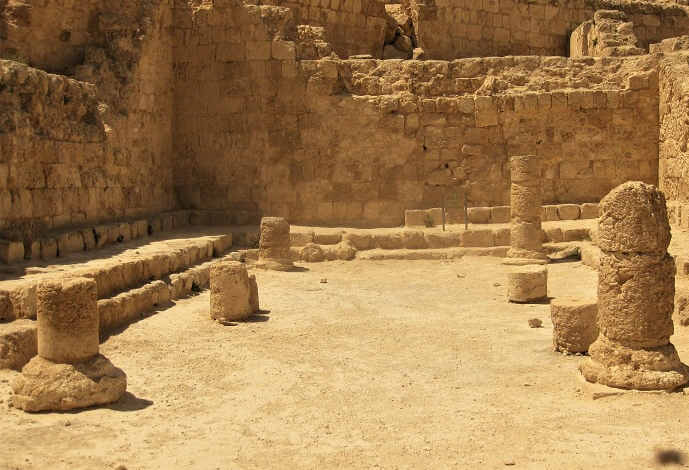
Herodium Synagouge, The Mandain Project
Herodium and its Synagogue, c. 20 BCE
About 7 miles south of Jerusalem, Herod the Great built a lavish palace at Herodium. Years after Herod's death, during the Great Revolt (66-74 CE), the Jews used the site as a base and built a synagogue, which can still be seen today.
Josephus, Wars 1.13.8
"Now in the place where Herod beat them, and killed a great number of them, there he afterward built a citadel, in memory of the great actions he did there, and adorned it with the most costly palaces, and erected very strong fortifications, and called it, from his own name Herodium."
Herodium is an ancient fortress located south of Jerusalem and
southeast of Bethlehem. It is a partly man-made mountain, on which are the
remains of Herod’s splendid palace including a bathhouse, fortifications, a
theatre, a large pool, and Herod's tomb.
After the Parthian invasion in 40 BCE when Herod fled to Masada he
encountered Jews loyal to his enemy Antigonus along the way. Heavy clashes ensuedwith Herod emerging victorious.
Josephus, Wars 1.13.8
"Now in the place where Herod beat them, and killed a great
number of them, there he afterward built a citadel, in memory of the great
actions he did there, and adorned it with the most costly palaces, and erected
very strong fortifications, and called it, from his own name Herodium."
Years after Herod's death, during the Great Revolt
(66-74 CE), the Jews used the site as a base and built a synagogue, which can
still be seen today.
Herod the Great Starts to Rebuild The Second Temple, 19 BCE
Josephus, Antiquities, 15.11.1
“And now Herod, in the eighteenth year of his reign…undertook a very great work; that is to build of himself the Temple of God, and make it larger in compass, and to raise it to a most magnificent altitude…”
City of David Megalim Institute, Courtesy of George Blumenthal and the Gol Family
Herod clashed with the Jews throughout his reign, especially the religious Jews and those opposing his rule, brutally persecuting them. In the 18th year of his reign, Herod announced that he would raze the former Temple built by the returnees from Babylon and build a more glorious one in its place. His plan was met with fierce scepticism. In an effort to gain their trust and make amends for his cruelty towards the rabbis, Herod prepared all the materials before the construction commenced. Josephus, Antiquities, 15.11.1 “And now Herod, in the eighteenth year of his reign…undertook a very great work; that is to build of himself the Temple of G-d, and make it larger in compass, and to raise it to a most magnificent altitude…” The construction was finished in therecord time of a year and a half. Watch the video by the City of David Megallim Institute, courtesy of the Gol Family and George Blumenthal, showing how the magnificent edifice was constructed.
Herod the Great Extends the Platform of the Second Temple

One of the most amazing feats in the construction of the new Temple was enlarging and levelling out the modest Mount Moriah, into a spacious platform that could hold significant crowds. Historians estimate that there were between six to seven million Jews living across the Roman Empire many of whomwould come to Jerusalem for the pilgrimage festivals. The large platform was achieved by building fortified retaining walls with a myriad of arches holding up the floor of the new mound from below. Even today, it remains the largest man-made platform in the world. Pictured here is the Temple platform sketch by archaeological architect, Leen Ritmeyer.
Leen Ritmeyer
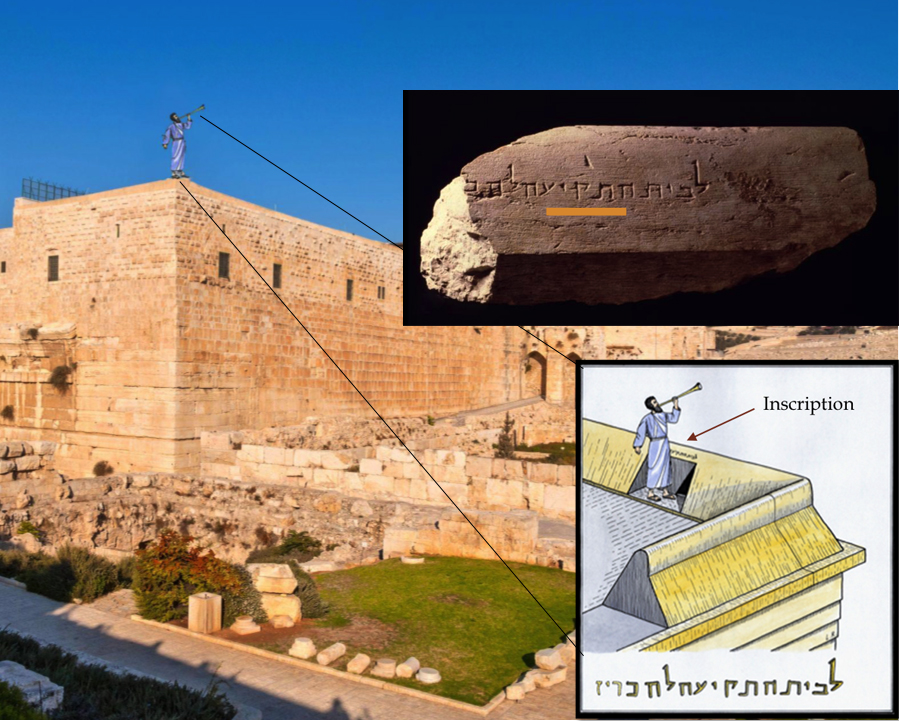
“To the Place of Trumpeting” to Declare the Sabbath on the Temple Mount
Josephus, War 4.9.12
“…the last [tower] was erected above the top of the Pastophoria: where one of the priests stood of course, and gave a signal beforehand, with a trumpet at the beginning of every seventh day, in the evening twilight: as also at the evening, when that day was finished: as giving notice to the people when they were to leave off work, and when they were to go to work again.”
Discovered by Prof Benjamin Mazar in 1968 during excavations
adjacent to Temple Mount, was a stone that formed the top southwest corner of
the Temple wall. On it was inscribed: (לבית התקיעה) "L'beit
HaTekiah" - "Belonging to the
place or “house” of trumpeting".
It was the sign at the place where priests would blow the silver trumpets
to notify the inhabitants of Jerusalem that the Sabbath was about to enter.
Another trumpeting would be sounded to announce the end of the sacred day.
Josephus, War 4.9.12
“…the last [tower] was
erected above the top of the Pastophoria: where one of the priests
stood of course, and gave a signal beforehand, with a trumpet at the
beginning of every seventh day, in the evening twilight: as also at the
evening, when that day was finished: as giving notice to the people when they
were to leave off work, and when they were to go to work again.”
Today, holding to the ancient tradition, the city
of Jerusalem still sounds a specific alarm to notify its residents of the
approach of the Sabbath.
Israel Antiquities Authority, Illustration by Leen Ritmeyer
Josephus Writes About the Beauty of Herod’s Temple
Josephus, Antiquities, 15.11.5
“…and the wall of the front (of the Temple) was adorned with beams, resting upon pillars, that were interwoven into it: and that front was all of polished stone. Insomuch that its fineness, to such as had not seen it was incredible: and to such as had seen it was greatly amazing.”
Herod's temple achieved fame and praise from around the ancient
world. Even Titus, who destroyed the Temple, called it “the glory of human
creation”.
Josephus, Antiquities, 15.11.5
“…and the
wall of the front (of the Temple) was adorned with beams, resting upon pillars,
that were interwoven into it: and that front was all of polished stone.
Insomuch that its fineness, to such as had not seen it was incredible: and to
such as had seen it was greatly amazing.”
Tower of David Museum,
Photo by Ardon Bar-Hama
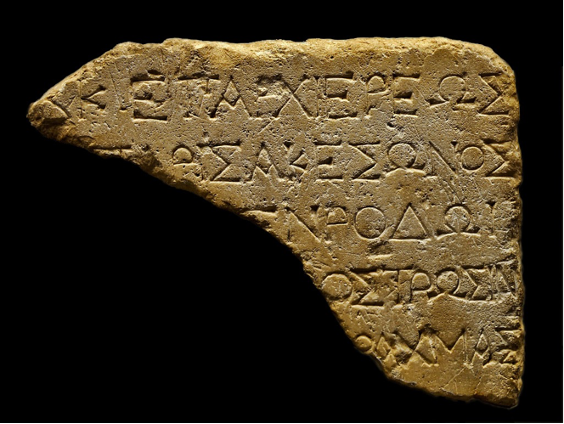
Funding of the Temple Paving
This inscription was discovered among the debris in a palace pool of the Herodian period south of the plaza that runs along the southern wall of the Temple Mount. The inscription mentions the donation of Paris, son of Akeson, of Rhodes, probably toward the cost of paving the Temple’s open southern court (Azara). According to Josephus, this court was paved with a variety of stones. This pavement was constructed, as the inscription notes, during the period of the Temple’s reconstruction, in the twentieth year of Herod’s reign (21 BCE), at the time of the High Priest Simon, son of Boethus.
Temple Paving Inscription:
“year 20 (Herod reign) during the time of the High Priest (Simon son of Boethus)... Paris son of Akeson of Rhodes pavement (of the southern Temple Court?)... drachmas …”
In this picture is an inscription that was discovered among the
debris in a palace pool of the Herodian period, south of the plaza that runs
along the southern wall of the Temple Mount. The inscription mentions the
donation of Paris, son of Akeson, of Rhodes, which was most likely investedtoward
the cost of paving the Temple’s open southern court or Azara. According to
Josephus, this court was paved with a variety of stones. This pavement was
constructed, as the inscription notes, during the period of the Temple’s
reconstruction, in the twentieth year of Herod’s reign (21 BCE), at the time of
the High Priest Simon, son of Boethus.
Temple Paving Inscription: “year 20 (Herod reign) during the time of the High
Priest (Simon son of Boethus)... Paris son of Akeson of Rhodes pavement (of the
southern Temple Court?)... drachmas …”
Golden Bell From the Clothing of a High Priest
Exodus 28:31-34
Description of the Priestly Garments
“You are to make the robe of the ephod entirely of blue cloth… Make pomegranates of blue, purple, and scarlet yarn all the way around the lower hem, with gold bells between them, alternating the gold bells and pomegranates around the lower hem of the robe.”
In 2011, a small golden bell in the shape of a round ball was found during excavations of the rainwater drainage channel under the stepped road leading up to Temple Mount. It had a loop at the top, for the purpose of attaching it to something else. Perhaps to the hem of the garment of a noble or important individual, as was customary at that time. Found very close to the foot of the Temple Mount on the road where the High Priest would have walked, especially during the water libation service of the Sukkot festival, archaeologists deduced that it might be one of the bells that adorned the hem of the garment of the High Priest himself. When Eli Shukrun, the overseeing archaeologist, shook the little ball, it rang like a bell. Research later revealed that it had a bell clapper inside. The Book of Exodus describes the Priestly Garments in chapter 28:31-34 “You are to make the robe of the ephod entirely of blue cloth… Make pomegranates of blue, purple, and scarlet yarn all the way around the lower hem, with gold bells between them, alternating the gold bells and pomegranates around the lower hem of the robe.”
City of David Excavations
Israel Antiquities Authority
Greek Inscription Prohibiting Non-Jews From Entering The Temple Courtyard
Temple Warning Inscription, Fragment Found in 1936:
“No foreigner shall enter within the forecourt and the balustrade around the sanctuary. Whoever is caught will have himself to blame for his subsequent death.”
Josephus, War 5.5.2
“When you go… unto the second [court of the] temple, there… stood pillars, at equal distances from one another; declaring the law of purity, some in Greek and some in Roman letters; that no foreigner should go within that sanctuary.”
Access to the Temple Courtyard was only given to Jews who priorly
immersed themselves in a mikveh for ritual purity.
Josephus, War 5.5.2 “When you go… unto the second [court of the] temple, there… stood
pillars, at equal distances from one another; declaring the law of purity, some
in Greek and some in Roman letters; that no foreigner should go within that
sanctuary.”
You are looking at a picture of a fragment of Greek inscription
prohibiting non-Jews from entering The Temple courtyard that was found in 1936.
It reads:
“No foreigner shall enter within the forecourt
and the balustrade around the sanctuary. Whoever is caught will have himself to
blame for his subsequent death.”
Israel Antiquities Authority / Israel Museum
The British Museum, London
An ossuary is a burial receptacle for the bones of the dead. In ancient tradition, the bones were collected approximately one year after the flesh had decayed and were placed in the ossuary. The ossuary’s size is the length of the femur bone, which is the longest bone in the body. Family tombs were common, especially among the rich. This is one of the reasons why the Bible refers to a person being "gathered to his fathers". In 1903 a limestone ossuary was discovered belonging to Nicanor. The inscription in Greek reads: “The bones of the family of Nicanor, the Alexandrian, who made the gates (of the Temple Mount).” Below it in Hebrew is written: “Nicanor Alexa” Nicanor of Alexandria donated two doors to the Temple which are referred to as the Gates of Nicanor. Opinions differ on their location and the time they were fashioned. The general opinion places the location between the Women’s court and the Temple courtyard with fifteen semi-circular steps leading up to it, on which Levites sang the fifteen “Psalms of the Steps” or Songs of Ascents that can be found in Psalms 120-134.
The Ossuary of Nicanor of Alexandria, Who Made Gates for Herod’s Temple, 10 BCE
Nicanor Ossuary, Discovered in 1903
Inscription in Greek: “The bones of the family of Nicanor, the Alexandrian, who made the gates (of the Temple Mount).”
Below in Hebrew: “Nicanor Alexa”
Ossuary of Simon the Temple Builder
Inscription in Aramaic: "Simon, the builder of the Temple"
read more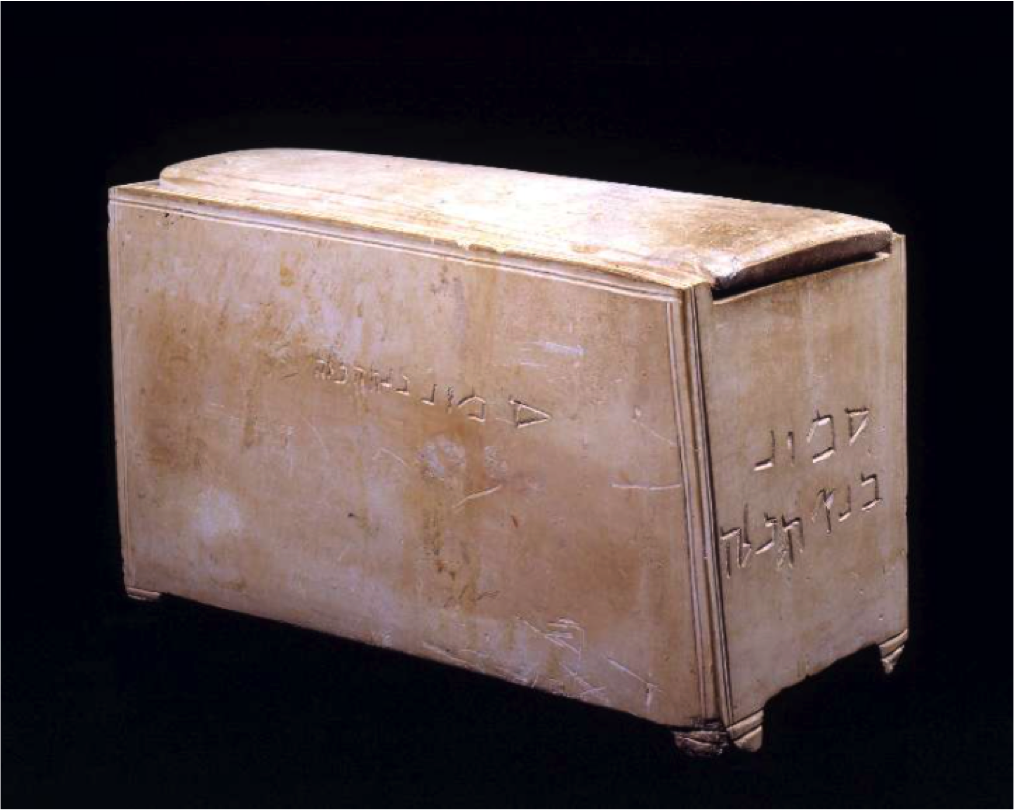
More ossuaries dating back to the second temple were found in Givat Hamivtar in a large tomb with several burial niches. Engraved in Aramaic on one of them is 'Simon Bana Hekhala", "Simon, builder of the Temple". The ossuary is of simple design indicating that he was most likely one of the builders of the Temple, perhaps a master mason or an engineer. It is on display in the Israel Museum.
Israel Museum / Israel Antiquities Authority
Herod Preserves the Olympic Games, 12 BCE
Josephus, Wars, 1.21.12
“... but then what favours he (Herod) bestowed on the Eleans was a donation not only in common to all Greece, but to all the habitable earth, as far as the glory of the Olympic games reached. For when he perceived that they were come to nothing, for want of money, and that the only remains of ancient Greece were in a manner gone, he not only became one of the combatants in that return of the fifth-year games, which in his sailing to Rome he happened to be present at, but he settled upon them revenues of money for perpetuity, insomuch, that his memorial as a combatant there, can never fail.”
In 12 BCE, receiving word that the Olympic Games, established in
the time of Grecian rule, were dwindling due to insufficient funds, Herod was
strongly moved to make large provisions to ensure its continuity.
Josephus, Wars, 1.21.12 “... but then what favours he (Herod) bestowed on
the Eleans was a donation not only in common to all Greece, but to all the
habitable earth, as far as the glory of the Olympic games reached. For when he
perceived that they were come to nothing, for want of money, and that the only
remains of ancient Greece were in a manner gone, he not only became one of the
combatants in that return of the fifth-year games, which in his sailing to Rome
he happened to be present at, but he settled upon them revenues of money for
perpetuity, insomuch, that his memorial as a combatant there, can never fail.”
Image: Shutterstock
Herod Institutes Greco-Roman Games in Judea
Josephus, Antiquites 15.8.1
“...he (Herod) appointed solemn games to be celebrated every fifth year, in honour of Cesar; and built a theatre at Jerusalem: as also a very great amphitheater in the plain.”
Clearly a passion of Herod, he also instituted the Greco-Roman
Games in Judea, a competitive sports festival intended to rival the Olympics.
Josephus, Antiquites 15.8.1
“...he (Herod) appointed solemn games to be
celebrated every fifth year, in honour of Cesar; and built a theatre at
Jerusalem: as also a very great amphitheatre in the plain (Caesarea).
The Herodian theater at Caesarea Maritima, Shutterstock, Anton Serkin
Herod Constructs Caesarea Maritima, 9 BCE
Josephus Antiquities 15.9.6
"Now upon his observation of a place near the sea,… he (Herod) set about getting a plan for a magnificent city there; and erected many edifices with great diligence all over it: and this of white stone. He also adorned it with most sumptuous palaces, and large edifices for containing the people; and what was the greatest and most laborious work of all, he adorned it with a haven, that was always free from the waves of the sea….As the city itself was called Cesarea…”
Previously, a Jewish settlement serving the shipbuilding industry, Herod transformed it into a majestic Roman city. One of his biggest projects, construction started in 22 BCE and finished in 9 BCE. In honour of Caeser Augustus, he called it Caesarea.
Hosting a deep-sea harbour, Caesarea was a cutting-edge, ultra-modern port and key commercial harbour in the ancient world of trade. Palaces, markets, storerooms, wide roads, bathhouses, and a pagan temple to Augustus and the goddess Roma formed part of the impressive city with the colossal hippodrome as the epicentre. Caesarea Maritima became the Capital of the Province of Judea in 6 BCE and retained that status till 132 CE.
Josephus Antiquities 15.9.6
"Now upon his observation of a place near the sea,… he (Herod) set about getting a plan for a magnificent city there; and erected many edifices with great diligence all over it: and this of white stone. He also adorned it with most sumptuous palaces, and large edifices for containing the people; and what was the greatest and most laborious work of all, he adorned it with a haven, that was always free from the waves of the sea….As the city itself was called Cesarea …”
Caesarea Maritima, Photo from Wikimedia Commons
"It is better to be Herod's pig than his son."
It is recounted by Roman historian Macrobius that Augustus remarked "It is better to be Herod's pig than his son," because of the many family members that Herod had executed on suspicion of treason, including sons Antipater, Alexander I, Aristobulus IV and wife Mariamne.
Josephus, Antiquities 16.11.7
"As for Herod, if he had before any doubt about the slaughter of his sons, there was now no longer any room left in his soul for it. But he had banished away whatsoever might afford him the least suggestion of reasoning better about this matter."
With suspicion and paranoia festering under his charismatic
character, Herod's psychological instability became unrestrained towards the
end of his life. Roman historian Macrobius recounted that Augustus himself
remarked "It is better to be Herod's pig than his son,"
because of the many family members that Herod had executed on suspicion of
treason, including his sons Antipater, Alexander I, Aristobulus IV, and his
beloved wife Mariamne I. Regaining clarity after his bouts of paranoiac
rage, Herod became haunted by their murders.
Josephus, Antiquities 16.11.7
"As for Herod, if he had before any doubt
about the slaughter of his sons, there was now no longer any room left in his
soul for it. But he had banished away whatsoever might afford him the least
suggestion of reasoning better about this matter."
The Death of Herod the Great, 4 BCE

Sarcophagus of Herod the Great, Found in Herodian, Displayed in the Israel Museum
Josephus, Antiquities, Book XVII, Chapters 6-8
"(Herod) spoke thus to them: ‘I shall die in a little time, so great are my pains. Which death ought to be cheerfully born, and to be welcomed by all men. But what principally troubles me is this; that I shall die without being lamented, and without such mourning as men usually expect at a King’s death…"
…
And now Herod altered his testament, upon the alteration of his mind. For he appointed Antipas, to whom he had before left the Kingdom, to be tetrarch of Galilee and Perea: and granted the Kingdom (of Judea) to Archelaus.”
Herod Antipas (the stepfather of Salome of the “Seven Veils”) and Herod Archelaus were the sons of Herod the Great.
Herod became seriously ill in 4 BCE when he was about 70 years old. While ill, he moved to his palace in Jericho. Josephus wrote at length about Herod's horrid illness including ulceration and terrible pains in the colon, malignancy, and purification of organs. Many agreed that his end was well-deserved with his brutal actions leaving him with no one to mourn him. Josephus, Antiquities, Book XVII, Chapters 6-8 "(Herod) spoke thus to them: ‘I shall die in a little time, so great are my pains. Which death ought to be cheerfully born, and to be welcomed by all men. But what principally troubles me is this; that I shall die without being lamented, and without such mourning as men usually expect at a King’s death…"…And now Herod altered his testament, upon the alteration of his mind. For he appointed Antipas, to whom he had before left the Kingdom, to be tetrarch of Galilee and Perea: and granted the Kingdom (of Judea) to Archelaus.” As Augustus did not confirm this revision, no one received the title of King. However, three of Herod’s sons, Herod Archelaus, Herod Antipas and Herod Philip II were ultimately granted rule of the stated territories.
This site was created with the Nicepage
